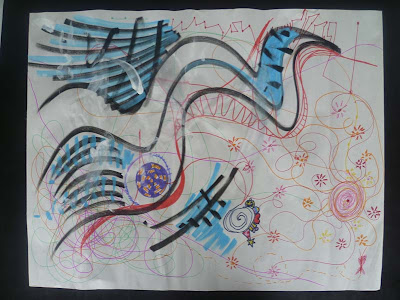'The Creative Flow project will enable young adult inpatients on the Cystic Fibrosis (CF) ward of the Bristol Royal Infirmary (BRI) to take part in therapeutic creative arts. By using the medium of creative arts the project will enable participants to undertake fun diversionary activities whilst in the care of the BRI and also provide an opportunity for the individuals to express their thoughts, feelings and communicate with others...'
For more information about the Creative Flow arts in health programme proposal please click here.
Friday, 11 November 2011
Sunday, 16 October 2011
Sounds of Life
Sounds of Life
In his book The Tao of Music, John M. Ortiz writes about how we use music to affect our mood and looks closely at how our mental health is affected by the music we choose to listen to. In one case study he talks about a client called Donna who became depressed; uncharacteristically tired, overeating and loosing self esteem. Ortiz encouraged he to make an ‘entrainment’ mix-tape, one of which reflected the low mood she was feeling. After some initial resistance she agreed and began compiling a series of sad and generally miserable tracks from her record collection. Once that side of the tape was recorded, she then added some more upbeat tracks that reflected the feelings she wanted to recapture on side 2. (Yes, this was an experiment that took place in the 1990’s when TDK 90 min cassette tapes were used daily to re-record and share music between one another – the original way to ‘illegally file-share’!)
Ortiz was interested to find that almost all of the songs Donna chose to put onto her mix-tape had some significant meaning to her and formed a sort of ‘life-soundtrack’. In later sessions together they discussed the meaning of each song and the relevance of the order in which they were compiled. Donna also revealed that she had used the tape on many occasions at home and in the car to affect her mood in a positive way; she felt that she had in some way gained control over her feelings and devised her own way of working through her depression by using music.
***
Last week I was introduced to the Ortiz text and asked to produce a music ‘life-line’ of my own, which I have just completed. Of all the things I have been asked to do during my 2 years so far studying on the Creative Arts Therapies course, this has to be one of my favourite – I couldn’t wait to get digging in my music collection! I am to share it with my new CATS group tomorrow, so I thought I would post it here for future reference. If you choose to listen to it, I hope you enjoy it - and I look forward to hearing your life story soon too.
MUSIC LIFELINE
:-)
In his book The Tao of Music, John M. Ortiz writes about how we use music to affect our mood and looks closely at how our mental health is affected by the music we choose to listen to. In one case study he talks about a client called Donna who became depressed; uncharacteristically tired, overeating and loosing self esteem. Ortiz encouraged he to make an ‘entrainment’ mix-tape, one of which reflected the low mood she was feeling. After some initial resistance she agreed and began compiling a series of sad and generally miserable tracks from her record collection. Once that side of the tape was recorded, she then added some more upbeat tracks that reflected the feelings she wanted to recapture on side 2. (Yes, this was an experiment that took place in the 1990’s when TDK 90 min cassette tapes were used daily to re-record and share music between one another – the original way to ‘illegally file-share’!)
Ortiz was interested to find that almost all of the songs Donna chose to put onto her mix-tape had some significant meaning to her and formed a sort of ‘life-soundtrack’. In later sessions together they discussed the meaning of each song and the relevance of the order in which they were compiled. Donna also revealed that she had used the tape on many occasions at home and in the car to affect her mood in a positive way; she felt that she had in some way gained control over her feelings and devised her own way of working through her depression by using music.
***
Last week I was introduced to the Ortiz text and asked to produce a music ‘life-line’ of my own, which I have just completed. Of all the things I have been asked to do during my 2 years so far studying on the Creative Arts Therapies course, this has to be one of my favourite – I couldn’t wait to get digging in my music collection! I am to share it with my new CATS group tomorrow, so I thought I would post it here for future reference. If you choose to listen to it, I hope you enjoy it - and I look forward to hearing your life story soon too.
MUSIC LIFELINE
:-)
Thursday, 6 October 2011
Closure
In our very last group session together the CATS 09-11 group revisited the exact same activity that we did 4 months earlier which i blogged about here. I wont go into too much detail as i have written a fair bit about this activity before but i did feel it worth posting the images from the second time round, if for no other reason than to compare them against each other.




















Our group as it was on the final day and so many missing faces. Perhaps not attending the very end part of a group is easier than saying goodbye, but i find real value in seeing it through to the end. It was great working with you all, i hope our paths will cross again soon...

Monday, 3 October 2011
Ending
Tuckman's 'stages of group development' theory looks at how people communicate with each other when they come together as a group and breaks it down into four stages; norming, storming, forming and performing. He later went on to add 'adjourning and transforming' to the sequence, referring to the breaking up and moving on of the group - the time when the group comes to an end.
Wednesday, 24 August 2011
Arts in Health with Inpatients on the Adult Cystic Fibrosis Ward
RESEARCH PROJECT CASE STUDY
Arts in Health with Inpatients on the Adult Cystic Fibrosis Ward (BRI)
July 2011
This short piece of research was conducted as part of the University of Plymouth’s Creative Arts Therapies foundation degree for the Professional Practice CoBC1111 module, and towards an ongoing personal investigation into the effects of creative arts activities on well-being.
Read the report HERE
Arts in Health with Inpatients on the Adult Cystic Fibrosis Ward (BRI)
July 2011
This short piece of research was conducted as part of the University of Plymouth’s Creative Arts Therapies foundation degree for the Professional Practice CoBC1111 module, and towards an ongoing personal investigation into the effects of creative arts activities on well-being.
Read the report HERE
Friday, 29 July 2011
Making a Bristol Dinosaur
Back in February Andy Council and i ran a workshop for young people the Bristol Museum and Art Gallery as part of the Bristol Dinosaur Project. The initial plan was to design a dinosaur skeleton using cut out images of Bristol architecture and then collaborate on a large wall painting, but the plan went from 2D to 3D when we thought about painting directly onto a dinosaur skeleton instead. Inspired by my nephews Christmas present of a balsa wood 'build your own' stegosaurus, we went about building a much larger version of our own out of MDF.
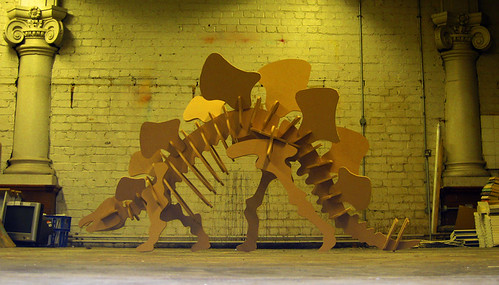 The hard work the young people we worked with put into transferring their impressions of Bristol onto each piece of the MDF 'bones' became realised when we assembled the pieces and the new Bristol Dinosaur appeared. You can see photographs of the process of the project on the Bristol City Museum and Art Gallery Facebook page.
The hard work the young people we worked with put into transferring their impressions of Bristol onto each piece of the MDF 'bones' became realised when we assembled the pieces and the new Bristol Dinosaur appeared. You can see photographs of the process of the project on the Bristol City Museum and Art Gallery Facebook page.

By working in a new way and pushing our own ideas of how we could facilitate a 'street art' style workshop, we produced a sculpture that displayed 10 young peoples views of Bristol that came together to make one finished piece - a very successful collaboration! But there was one point when we needed to fill an hour with some idea brain storming, so i took a risk and got the collaborative free drawing going. The rules would be different this time though, draw anything with a theme of 'Bristol', use coloured oil pastels and silence is merely optional!
I'll let the images do the talking...




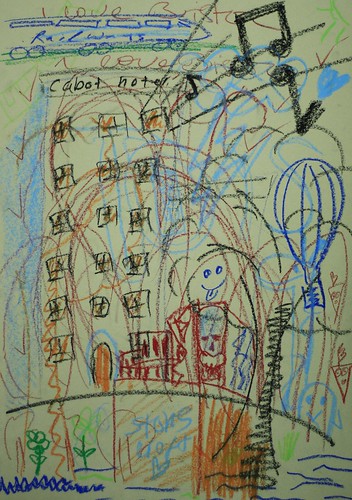
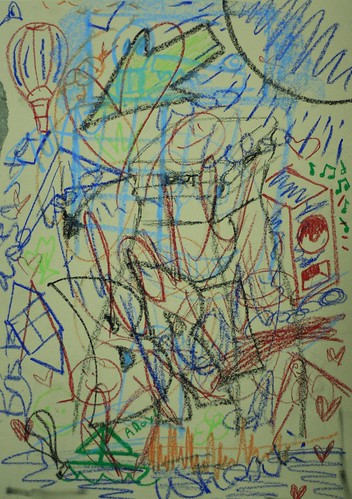
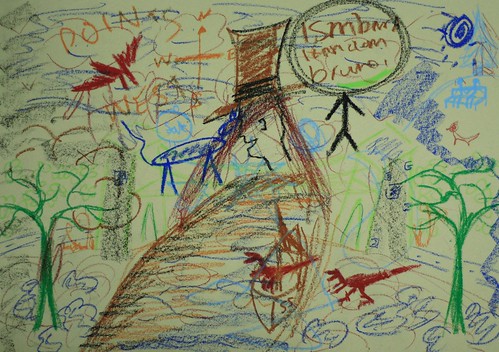

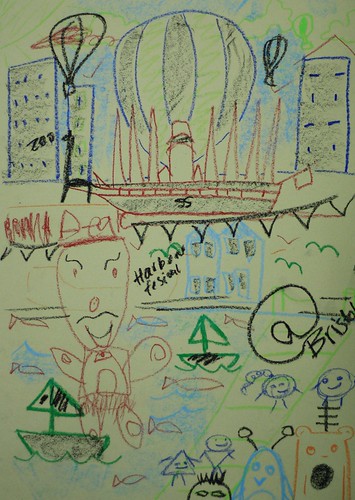

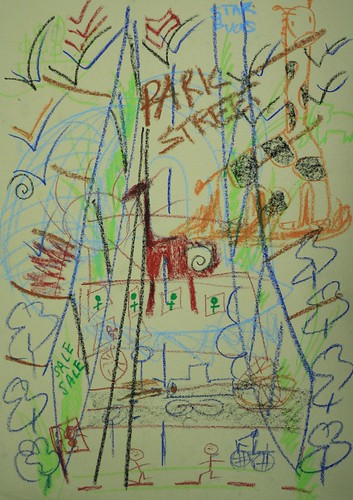


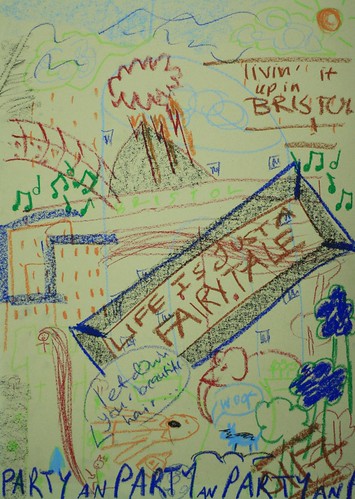

 The hard work the young people we worked with put into transferring their impressions of Bristol onto each piece of the MDF 'bones' became realised when we assembled the pieces and the new Bristol Dinosaur appeared. You can see photographs of the process of the project on the Bristol City Museum and Art Gallery Facebook page.
The hard work the young people we worked with put into transferring their impressions of Bristol onto each piece of the MDF 'bones' became realised when we assembled the pieces and the new Bristol Dinosaur appeared. You can see photographs of the process of the project on the Bristol City Museum and Art Gallery Facebook page.
By working in a new way and pushing our own ideas of how we could facilitate a 'street art' style workshop, we produced a sculpture that displayed 10 young peoples views of Bristol that came together to make one finished piece - a very successful collaboration! But there was one point when we needed to fill an hour with some idea brain storming, so i took a risk and got the collaborative free drawing going. The rules would be different this time though, draw anything with a theme of 'Bristol', use coloured oil pastels and silence is merely optional!
I'll let the images do the talking...















Thursday, 21 July 2011
Free Drawing: The Images
It's been a couple of months since i've had the time to get this blog going, but i've been putting all the energies into the doing and a lot less into recording the reflecting. Over the next few weeks I'll be spending a bit more time writing up some of the projects i have been doing with all sorts of different people in Bristol and i'll endevour to get the results posted here.
Before that though, it feels wrong to continue without posting the images that accompany the previous Free Drawing post...









Before that though, it feels wrong to continue without posting the images that accompany the previous Free Drawing post...









Thursday, 19 May 2011
Creative Writing
I cdnuolt blveiee taht I cluod aulaclty uesdnatnrd waht I was rdanieg...
The phaonmneal pweor of the hmuan mnid. Aoccdrnig to rscheearch at Cmabrigde Uinervtisy, it deosn’t mttaer inwaht oredr the ltteers in a wrod are, the olny iprmoatnt tihng is taht the frist and lsat ltteer be in the rghit pclae. The rset can be a taotl mses and you can sitll raed it wouthit a porbelm. Tihs is bcuseae the huamn mnid deos not raed ervey lteter by istlef, but the wrod as a wlohe. Amzanig huh? yaeh and I was awlyas tlod taht slpeling was ipmorantt.
The phaonmneal pweor of the hmuan mnid. Aoccdrnig to rscheearch at Cmabrigde Uinervtisy, it deosn’t mttaer inwaht oredr the ltteers in a wrod are, the olny iprmoatnt tihng is taht the frist and lsat ltteer be in the rghit pclae. The rset can be a taotl mses and you can sitll raed it wouthit a porbelm. Tihs is bcuseae the huamn mnid deos not raed ervey lteter by istlef, but the wrod as a wlohe. Amzanig huh? yaeh and I was awlyas tlod taht slpeling was ipmorantt.
Thursday, 5 May 2011
Free Drawing
Free Drawing
“It’s not about good drawing, it’s about drawing good.” (1)
Nick Moore recently introduced me to a creative arts activity that asked some interesting questions about ownership, value and worth. It wasn’t given a name but could perhaps be described as collaborative ‘free drawing’, and I enjoyed it immensely.
The activity involved a group of people (in this instance 14 students including myself) stood in a circle around an island of tables, each with an A2 piece of cartilage paper a chunky 6B graphite stick. With no theme or subject given we were simply asked to start drawing in silence. After about 2 or 3 minutes, just as I felt as if our group were becoming adjusted to the task and starting to become focused, we were asked to move our drawings to the person on our right and continue to draw on the one we received. This process continued, every few minutes passing the drawings on to our right; 14 times until we eventually ended up with the piece of paper that we had begun with. Our original drawings were now filled with 13 new and unique marks made by each person in the group, filling up the page and completing the artwork.
We then took a nice long tea break, taking in the opportunity to have a good look at the intensely energetic and detailed pictures we had created.
Activities like this enthuse and inspire me. Over the space of 40 minutes or so we had built a body of work that was truly fascinating to look at. Each image contained a series of marks made by each one of us; one person’s mark relating to the next person’s, forming controlled but totally random compositions. Each image was full of line, tone and shading, but also included representations of household objects, figures of people, animals and architecture. Some text resembled bold comic book style lettering, whilst other areas contained sentences stating thoughts, moods and feelings. I found it alluring to see the communication between different people’s markings and how they all began to relate to each other, capturing a snap shot of each one of us as individuals but also as a larger collective group at that very moment in time. Here the process felt as if it held far more value than the outcome.
But I couldn’t help sensing that not everyone shared my enthusiasm for this way of working. Thankfully this unease was addressed by the group (after washing up the tea cups) in a review session and with Nick as facilitator, we discussed how it felt for each of us whilst working through the activity. There appeared to be a sense of lost ownership from many who resented having to give up their initial drawings to be defaced by others, combined with a sense of guilt when beginning to draw on someone else’s artwork. Who now truly owned the piece was vehemently questioned and there was clearly some discomfort surrounding the signing of the finished pieces and claiming them as our own work. And I understand that completely…
Within the world of the graffiti art subculture artists painting over each others work is common practice. In towns such as Bristol there are a growing number of street based artists and not enough public spaces for artists to continually keep on producing new work, so it is inevitable that spaces that are permitted for painting see a high turnover of different artists work. As an active artist in this field, you have to accept that you are going to paint over another artists work and in turn, it is certain that another artist will go over yours. In my early days of writing graffiti, I found this hard to take. I didn’t like painting over other peoples paintings and I didn’t respond well when someone went over one of mine. But over time this became less important to me and I began to feel less precious about making art on the streets. In accepting that the artworks I painted were transient it loosened my approach to painting graffiti, freeing up space to try new things and push new ideas.
However this process took a long time; and over that time I was able to work through the same emotions that were felt be my peers during the free drawing exercise. What I gained from the graffiti art subculture was the realisation that street art cannot be precious; it is a temporary art form and as such we have to accept that the work we put out will inevitably have a limited lifespan. In many ways becoming less precious about the art we make allows us to take more risks – not worrying about the outcome opens up more space for creativity during the process.
I wonder if the most precious part of any artwork is not the finished piece itself but the story behind the context in which it was created…?
(1) Shaun D McMillan
“It’s not about good drawing, it’s about drawing good.” (1)
Nick Moore recently introduced me to a creative arts activity that asked some interesting questions about ownership, value and worth. It wasn’t given a name but could perhaps be described as collaborative ‘free drawing’, and I enjoyed it immensely.
The activity involved a group of people (in this instance 14 students including myself) stood in a circle around an island of tables, each with an A2 piece of cartilage paper a chunky 6B graphite stick. With no theme or subject given we were simply asked to start drawing in silence. After about 2 or 3 minutes, just as I felt as if our group were becoming adjusted to the task and starting to become focused, we were asked to move our drawings to the person on our right and continue to draw on the one we received. This process continued, every few minutes passing the drawings on to our right; 14 times until we eventually ended up with the piece of paper that we had begun with. Our original drawings were now filled with 13 new and unique marks made by each person in the group, filling up the page and completing the artwork.
We then took a nice long tea break, taking in the opportunity to have a good look at the intensely energetic and detailed pictures we had created.
Activities like this enthuse and inspire me. Over the space of 40 minutes or so we had built a body of work that was truly fascinating to look at. Each image contained a series of marks made by each one of us; one person’s mark relating to the next person’s, forming controlled but totally random compositions. Each image was full of line, tone and shading, but also included representations of household objects, figures of people, animals and architecture. Some text resembled bold comic book style lettering, whilst other areas contained sentences stating thoughts, moods and feelings. I found it alluring to see the communication between different people’s markings and how they all began to relate to each other, capturing a snap shot of each one of us as individuals but also as a larger collective group at that very moment in time. Here the process felt as if it held far more value than the outcome.
But I couldn’t help sensing that not everyone shared my enthusiasm for this way of working. Thankfully this unease was addressed by the group (after washing up the tea cups) in a review session and with Nick as facilitator, we discussed how it felt for each of us whilst working through the activity. There appeared to be a sense of lost ownership from many who resented having to give up their initial drawings to be defaced by others, combined with a sense of guilt when beginning to draw on someone else’s artwork. Who now truly owned the piece was vehemently questioned and there was clearly some discomfort surrounding the signing of the finished pieces and claiming them as our own work. And I understand that completely…
Within the world of the graffiti art subculture artists painting over each others work is common practice. In towns such as Bristol there are a growing number of street based artists and not enough public spaces for artists to continually keep on producing new work, so it is inevitable that spaces that are permitted for painting see a high turnover of different artists work. As an active artist in this field, you have to accept that you are going to paint over another artists work and in turn, it is certain that another artist will go over yours. In my early days of writing graffiti, I found this hard to take. I didn’t like painting over other peoples paintings and I didn’t respond well when someone went over one of mine. But over time this became less important to me and I began to feel less precious about making art on the streets. In accepting that the artworks I painted were transient it loosened my approach to painting graffiti, freeing up space to try new things and push new ideas.
However this process took a long time; and over that time I was able to work through the same emotions that were felt be my peers during the free drawing exercise. What I gained from the graffiti art subculture was the realisation that street art cannot be precious; it is a temporary art form and as such we have to accept that the work we put out will inevitably have a limited lifespan. In many ways becoming less precious about the art we make allows us to take more risks – not worrying about the outcome opens up more space for creativity during the process.
I wonder if the most precious part of any artwork is not the finished piece itself but the story behind the context in which it was created…?
(1) Shaun D McMillan
Tuesday, 19 April 2011
'Artist'
Artist
For some time I have been questioning the term ‘Graffiti Artist’, considering exactly what it means to me. For ten or more years I used it to describe myself and the work I created but more recently I have felt less comfortable with using it.
The term graffiti is used to illustrate anything from marks made on a surface to intricate and colourful paintings made with spray cans. However the word has its roots in archaeological science, defined as ‘inscriptions or drawings scratched or carved onto a surface.’(1)
Growing up in the inner-city around people who used spray cans to write their names elaborately on walls was exciting and I soon joined in, loving finding a new way to channel my creativity, surrounded and encouraged by likeminded friends. But I also enjoyed being known as a graffiti artist and the sense of belonging that it brought.
But of late I don’t feel like the term fits anymore – especially as this week I realised that it has been over a year since I went out with a bag full of cans and did a letter based painting. I’ve started to question if I was ever really truly a ‘graffiti’ artist in the more original sense of the word. In workshop sessions with young people I have become more sensitive to using the term and have begun to refer to the letter based designs we make as ‘New York style graffiti’, with style and technique taken from the American graffiti subculture. I think it is important to recognise the origins of that particular movement and separate it from all of the other graffiti artists and movements that there are, and have been since the beginnings of time – cavemen, ancient Egyptians, political activists, street gangs, freight train riding hobo’s, Arthur Stace and a perhaps a million others…
Whilst reading through the recent edition of Juxtapoz magazine I was surprised to see that the NY godfather of the graffiti art subculture Fab 5 Freddy had summed up my thoughts exactly – only he had posed the same questions to himself some 30 years ago.
“In the 80’s, we were reluctant to refer to ourselves as ‘graffiti artists’, but the media descended and called us that. Out of our respect and reverence for the process and practice, we were conscious that we weren’t technically doing ‘graffiti’, as the true meaning of that term is akin to making and illegal mark or scrawl on a wall.
But I am aware that meanings of words expand based on popular usage over time. I like to use the term New York style graffiti because that explains the style of spray painting and tagging developed in New York in the ‘70s and ‘80s and most associated with graffiti as an art. Some use the term aerosol artist to reference that they are using spray paint but not necessarily creating graffiti in that New York style.” (2)
I’ve learned so much from painting NY influenced graffiti that it is hard to drop the ‘graffiti’ from ‘artist’. But I use a lot more brushes and acrylic these days - sometimes I don’t even use spray paint in my works at all…
I think it makes more sense to be free of all the expectations and just be an artist.
1) http://www.thefreedictionary.com/graffiti
2) Fab 5 Freddy interview Juxtapoz Magazine April 11
For some time I have been questioning the term ‘Graffiti Artist’, considering exactly what it means to me. For ten or more years I used it to describe myself and the work I created but more recently I have felt less comfortable with using it.
The term graffiti is used to illustrate anything from marks made on a surface to intricate and colourful paintings made with spray cans. However the word has its roots in archaeological science, defined as ‘inscriptions or drawings scratched or carved onto a surface.’(1)
Growing up in the inner-city around people who used spray cans to write their names elaborately on walls was exciting and I soon joined in, loving finding a new way to channel my creativity, surrounded and encouraged by likeminded friends. But I also enjoyed being known as a graffiti artist and the sense of belonging that it brought.
But of late I don’t feel like the term fits anymore – especially as this week I realised that it has been over a year since I went out with a bag full of cans and did a letter based painting. I’ve started to question if I was ever really truly a ‘graffiti’ artist in the more original sense of the word. In workshop sessions with young people I have become more sensitive to using the term and have begun to refer to the letter based designs we make as ‘New York style graffiti’, with style and technique taken from the American graffiti subculture. I think it is important to recognise the origins of that particular movement and separate it from all of the other graffiti artists and movements that there are, and have been since the beginnings of time – cavemen, ancient Egyptians, political activists, street gangs, freight train riding hobo’s, Arthur Stace and a perhaps a million others…
Whilst reading through the recent edition of Juxtapoz magazine I was surprised to see that the NY godfather of the graffiti art subculture Fab 5 Freddy had summed up my thoughts exactly – only he had posed the same questions to himself some 30 years ago.
“In the 80’s, we were reluctant to refer to ourselves as ‘graffiti artists’, but the media descended and called us that. Out of our respect and reverence for the process and practice, we were conscious that we weren’t technically doing ‘graffiti’, as the true meaning of that term is akin to making and illegal mark or scrawl on a wall.
But I am aware that meanings of words expand based on popular usage over time. I like to use the term New York style graffiti because that explains the style of spray painting and tagging developed in New York in the ‘70s and ‘80s and most associated with graffiti as an art. Some use the term aerosol artist to reference that they are using spray paint but not necessarily creating graffiti in that New York style.” (2)
I’ve learned so much from painting NY influenced graffiti that it is hard to drop the ‘graffiti’ from ‘artist’. But I use a lot more brushes and acrylic these days - sometimes I don’t even use spray paint in my works at all…
I think it makes more sense to be free of all the expectations and just be an artist.
1) http://www.thefreedictionary.com/graffiti
2) Fab 5 Freddy interview Juxtapoz Magazine April 11
Saturday, 12 March 2011
Subscribe to:
Posts (Atom)




